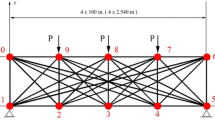Abstract
Truss layout optimization is a procedure for optimizing truss structures under the combined influence of size, shape and topology variables. This paper presents an Improved Genetic Algorithm with Two-Level Approximation (IGATA) that uses continuous shape variables and shape sensitivities to minimize the weight of trusses under static or dynamic constraints. A uniform optimization model including continuous size/shape variables and discrete topology variables is established. With the introduction of shape sensitivities, the first-level approximations of constraint functions are constructed with respect to shape/topology/size variables. This explicit problem is solved by implementation of a real-coded GA for continuous shape variables and binary-coded GA for 0/1 topology variables. Acceleration techniques are used to overcome the convergence difficulty of the mixed-coded GA. When calculating the fitness value of each member in the current generation, a second-level approximation method is embedded to optimize the continuous size variables effectively. The results of numerical examples show that the usage of continuous shape variables and shape sensitivities improves the algorithm performance significantly.























Similar content being viewed by others
References
Azid IA, Kwan ASK, Seetharamu KN (2002) An evolutionary approach for layout optimization of a three-dimensional truss. Struct Multidiscip Optim 24(4):333–337
Balling RJ, Briggs RR, Gillman K (2006) Multiple optimum size/shape/topology designs for skeletal structures using a genetic algorithm. J Struct Eng 132(7):1158–1165
Dong Y, Huang H (2004) Truss topology optimization by using multi-point approximation and GA. Chinese J Comput Mec 21(6):746–751
Dorn WC, Gomory RE, Greenberg HJ (1964) Automatic design of optimal structures. J de Mecanique 31:25–52
Hansen SR, Vanderplaats GN (1990) Approximation method for configuration optimization of trusses. AIAA J 28(1):161–168
Jin J, Yang X, Ding J. (2000) Real Coding Based Acceleration Genetic Algorithm. Journal of Sichuan University
Kirsch U (1990) On the relationship between optimum structuraltopologies and geometries. Struct Optim 2(1):39–45
Li D, Chen S, Huang H (2014) Improved genetic algorithm with two-level approximation for truss topology optimization. Struct Multidiscip Optim 49(5):795–814
Lin jH, Che WY, Yu YS (1982) Structural optimization on geometrical configuration and element sizing with statical and dynamical constraints. Comput Struct 15(5):507–515
Pederson, P. (1970) On the Minimum Mass Layout of Trusses Advisory Group for Aerospace Research and Development, Conf. Proc. No. 36, Symposium on Structural Optimization, AGARD-CP-36-70
Rajan SD (1995) Sizing, shape and topology design optimization of trusses using genetic algorithm. J Struct Eng 121(10):1480–1487
Rajeev S, Krishnamoorthy CS (1997) Genetic algorithms-based methodologies for design optimization of trusses. J Struct Eng 123(3):350–358
Rozvany GIN (1996) Difficulties in truss topology optimization withstress, local buckling and system stability constraints. Struct Optim 11(3–4):213–217
Rozvany GN, Bendsoe MP, Kirsch UU (1995) Layout optimization of structures. ASME Appl Mech Rev 48(2):41–119. doi:10.1115/1.3005097
Sadaji O (1992) Asai Kazuhiro a hybrid optimal synthesis method for truss structures considering shape, material and sizing variables. Int J Numer Methods Eng 34(3):839–851
Schmit, L. A. (1960) Structural Design by Systematic Synthesis, Proceedings, Second National Conference on Electronic Computation, ASCE, Pittsburgh, Pa.,Sept., pp. 105–132.
Schmit, L. A., Mallett, R. H. (1963) Structural-Synthesis and Design Parameter Hierarchy, Journal of the Structural Division, ASCE, Vol. 89, No. ST4, Aug., pp. 269–299.
Shen-yan Chen, Xiao-fang Shui, Dong-fang Li, and Hai Huang (2015) Improved Genetic Algorithm with Two-Level Approximation for Truss Optimization by Using Discrete Shape Variables, Mathematical Problems in Engineering, vol. 2015, Article ID 521482, 11 pages, 10.1155/2015/521482
Svanberg K (1981) Optimization of geometry in truss design. Comput Methods Appl Mech Eng 28(1):63–80
Tang W, Tong L, Gu Y (2005) Improved genetic algorithm for design optimization of truss structures with sizing, shape and topology variables. Int J Numer Methods Eng 62(13):1737–1762
Topping BHV (1983) Shape optimization of skeletal structures:a review. J Struct Eng ASCE 109:1933–1951
Wu SJ, Chow PT (1995) Integrated discrete and configuration optimization of trusses using genetic algorithms. Comput Struct 55(4):695–702
Zhang Z, Yao W, Zhou L (2012) Study on size and shape collaborative optimization method of truss structure, advances in aeronautical science and. Engineering 3(2):138–143
Zhou M, Rozvany GIN (1991) The coc algorithm, part ii: topological, geometrical and generalized shape optimization. Comput Methods Appl Mech Eng 89:309–336
Zhou M, Xia RW (1990a) An efficient method of truss design for optimum geometry. Comput Struct 35(2):115–119
Zhou M, Xia RW (1990b) Two-level approximation concept in structural synthesis. Int J Numer Methods Eng 29(8):1681–1699
Acknowledgments
This research work is supported by the National Natural Science Foundation of China (Grant No.11302010), which the authors gratefully acknowledge. The insightful comments of the reviewers are cordially appreciated.
Author information
Authors and Affiliations
Corresponding author
Rights and permissions
About this article
Cite this article
Chen, Sy., Shui, Xf. & Huang, H. Improved genetic algorithm with two-level approximation using shape sensitivities for truss layout optimization. Struct Multidisc Optim 55, 1365–1382 (2017). https://doi.org/10.1007/s00158-016-1583-2
Received:
Revised:
Accepted:
Published:
Issue Date:
DOI: https://doi.org/10.1007/s00158-016-1583-2




